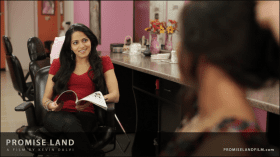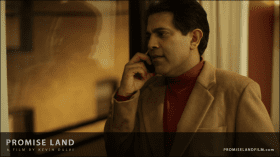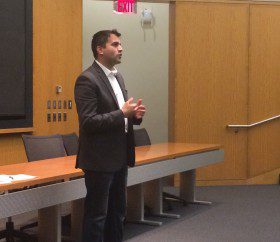“In America, I don’t think many South Asians get a lot of mainstream roles. I think they’re starting to get those roles but when we made the film a couple of years ago, there weren’t a lot of opportunities.” – Kevin Dalvi
On Thursday, July 31st, film director Kevin Dalvi visited Harvard to screen his film Promise Land as part of the South Asia Institute’s Annual Summer Film Series.
With immigration as a central theme, Promise Land’s three stories, all set in Chicago, intertwine in a gripping tale of love, conflict, and hope. These compelling narratives reveal the unique challenges and triumphs of the characters as they struggle to keep their families together and pursue their dreams in a place they have come to call home.
One story follows a same-sex couple expecting a baby and struggling with one partner’s meddling mother; another tells the story of the Khan family as they learn to navigate the legal hoops of immigration law that threatens to split up their family; and another story depicts employees of an IT sweatshop, who feel trapped in their job due to unfair immigration policies.
Following the screening, Dalvi engaged in a Q+A with the audience. He discussed obstacles facing many South Asian immigrants, and what it’s like to shoot a full-length feature film with an ensemble cast in just 16 days.
Audience Question: I really enjoyed the movie. I’m just curious about where the idea for the film came from, where the project sort of unfolded. Why did you decide to have not just Indian cast members but Pakistani cast members and where that sort of where that came about?
 Kevin Dalvi: Sure. That’s a great question. I interviewed almost 20-22 groups of immigrants based in Chicago, New York, or California. When I was interviewing them, I realized that everybody had their own story to tell. They’re really heartbreaking stories where the kids had to go back [to the country they were born], and there was another Indian couple where one partner had to go back to India. What I did not want to do is make it specific to Indians, or specific to Pakistanis. I wanted to represent South Asia.
Kevin Dalvi: Sure. That’s a great question. I interviewed almost 20-22 groups of immigrants based in Chicago, New York, or California. When I was interviewing them, I realized that everybody had their own story to tell. They’re really heartbreaking stories where the kids had to go back [to the country they were born], and there was another Indian couple where one partner had to go back to India. What I did not want to do is make it specific to Indians, or specific to Pakistanis. I wanted to represent South Asia.
The original script that we had written for Promised Land actually had individuals from different cultures: South Asia, Africa, we had a Polish family. But it was too much going on in the film. When I read through the script a couple of times, I figured that we should focus on one culture and so we decided to focus on the South Asian culture.
Q: The actors and actresses- they look like real live people. They’re not big stars or anything. How did you pick them up and with such short time?
KD: I went to every single one of them and I told them I have this story I really want to tell. Everyone kept shutting me down for months. Literally, it took me four months to find all the actors because we had 50 actors and another 50 crew members. But one of them, the actor who plays Dr. Khan 9 [Kamal Hans], he plays the Indian Ambassador or Indian president in a lot of movies so he’s done a lot of films, for example with Matt Damon in Contagion.
Some of the actors are pretty famous, but in America, I don’t think a lot of South Asians get a lot of mainstream roles. I think they’re starting to get those roles but when we made the film a couple of years ago, there weren’t a lot of opportunities. I think when they saw the script, they wanted to tell the story and I think that’s what got them excited about the project.
 Roopa Modha [Manager of marketing for the film]: I just wanted to add one thing to what Kevin said. I had a chance to interview the cast during the last premier that we did. The couple that you see in the movie, the lesbian couple, they told me they met only a few minutes before the actual shooting began. Despite that, look at the chemistry they were able to create.
Roopa Modha [Manager of marketing for the film]: I just wanted to add one thing to what Kevin said. I had a chance to interview the cast during the last premier that we did. The couple that you see in the movie, the lesbian couple, they told me they met only a few minutes before the actual shooting began. Despite that, look at the chemistry they were able to create.
I think Kevin is able to choose people that really suited those roles. He interviewed so many people to come up with this final product. And yet, these actors, even meeting for just a couple of minutes beforehand were able to bring to life so much about this story because without them, you obviously would not have seen the impact on this audience. Good job, Kevin, for putting all this together.
KD: One interesting thing about the movie is that we actually shot three different films and the actors hadn’t seen the other films. So when they saw the film for the first time, that was the first time they actually saw the full movie. So, it’s like we shot three films in 16 days. It was crazy because we had a different cast, different crew, every day, and that was pretty exciting to make this film. When the actors saw it, they had no idea how these stories were connected to each other till they actually saw the film. That was interesting.
Q: This was pretty impressive for a first film. Did you study filmmaking or have you done shorts? This is really your first film?
KD: Yeah, I wrote this story, I was working on the script for three or four months and then I did pre-production for about a month and the actual filming itself was for 16 days. But yeah, this is my first film. I did a short for the New Orleans Film Festivals a couple of years ago but I was only a PA [production assistant] on that short and when I watched this film, I felt that I could have done better. But you know what? It’s your first film so there’s only so much you could do. Hopefully, the next one will be even better.
 Q: I have two questions, first about the actors who played the two girlfriends in the same sex relationship. My question is, why does the American have to be a straight-haired blonde?
Q: I have two questions, first about the actors who played the two girlfriends in the same sex relationship. My question is, why does the American have to be a straight-haired blonde?
My other comment, completely different, is that many of us, those of us from the East coast or whose grandparents came through Ellis Island, we hear about families coming in pieces…But this film, it opened us up to the fact that sometimes families have to go back in pieces. That’s just horrible.
KD: I appreciate the question. I tried so hard to break stereotypes with this film. Most South Asian films are about identity and this film was not about identity. Even with the actors, I was trying to cast someone else who was not blonde but it just worked out that she [Brenda Barrie] was the best actor out of everybody that auditioned. They just had great chemistry. We literally found her two days before filming the movie. She helped us out quite a bit.
Q: Kevin, could you expand more on the scene with the Muslim family [in which the family’s immigration lawyer insulted the family because they were Muslim in post-9/11 America]? That was really disturbing. So is that the mindset of immigration lawyers right now? Is that a difficulty encountered by Pakistanis and Muslims when dealing with immigration law?
KD: So, that scene was actually a quote from one of the couples that I interviewed. When they went to the lawyer, the lawyer said something like, “You are Muslim, so you must be from the Middle East and we don’t want to support anyone from the Middle East.” That happened to them right after 9/11, so the sentiments were pretty high and that was actually from their true story. It was just pretty heartbreaking when they told their story, but obviously there’s a little bit of creativity and fiction involved, but some of those dialogues and scenes actually did happen.
Q: I had a question about the cast – it was very well cast. I recognized the actor who played the father, and I recognized the actress who played Saniya. How did you choose the actors? Were they known, locally or in the Chicago area? Did you bring people in from New York, or India, or Pakistan?
KD: No, they were all New York or Chicago-based. At the time that we shot the film, none of them were really big actors. The daughter that you recognize, she is starting to show up in a lot of Fox TV shows, and NBC TV shows. So now they are starting to build their career. But when we shot the film, they were based out of Chicago or New York, and they just wanted to be part of a meaningful project – not another horror film, which is basically what they told me. When they read the script, they really wanted to support the cause, and go on an adventure. Going into it, no one thought it was possible to shoot a film in the time span that we had, so it was quite an adventure for all of us.
This interview has been edited lightly for clarity and length.

